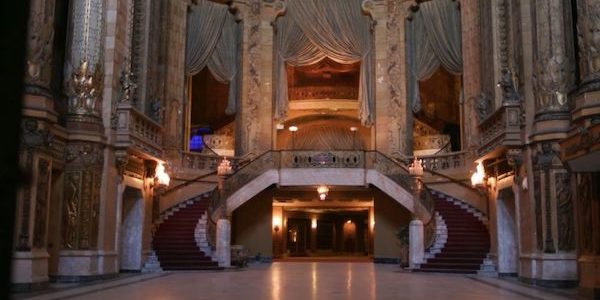
2019 Heartland Film Festival: ‘Going Attractions: The Definitive Story of the Movie Palace’ ★★★½
For tickets/showtimes or more information about Heartland Film Festival, please click:
By Bob Bloom
The movie-going experience is a pale shadow of what it once was. Today, multiplexes offer cookie-cutter, dull-looking, 100-300 seat theaters with screens sometimes comparable to large-size flat-screen televisions.
The theaters lack the ambiance that used to make going to the movies a magical time.
The documentary, “Going Attractions: The Definitive Story of the Movie Palace” tries to capture and explain how these cinematic cathedrals heightened the joy of seeing your favorite stars on the big screen.
The era of the movie palace began after World War I, when spectacular venues were created by architects who, hired by theater-chain owners or heads of movie studios — which at the time owned their own chains — were given free rein to design structures that would draw people to them.
The creators of these sites were influenced by various architectural styles influenced by Moorish and European churches and palaces.
These new theaters attracted audiences of all classes — a high-society patron paid the same for a ticket as a working-class individual.
As theater owner Marcus Loew said in the early 1920s, “We don’t sell tickets to movies; we sell tickets to theaters.”
Among those taking us on a journey through this era is film historian-author Leonard Maltin, Escott A. Norton, executive director of the Los Angeles Historical Theatre Foundation, Barbara Twist, former managing director of Art House Convergence and Richard Fosbrink, former executive director of the Theatre Historical Society.
They describe the interior of these theaters and their allure — ushers in crisp, military-style uniforms who helped patrons to their seats, Wurlitzer organs or orchestras, which, in the silent era, accompanied pictures and — in the sound era — performed prologues to entertain audiences before the start of a film.
Aiding the boom in movie palaces was the investment by movie studios, which owned theater chains aimed at promoting that studio’s product. Warner Bros., MGM, 20th Century Fox and RKO all owned movie theaters throughout the country — as well as movie palaces in metropolitan areas, such as New York, Chicago and Los Angeles.
Writer-director April Wright’s documentary looks not only at the rise of the movie palaces but explains their demise, as well as efforts today to save remaining buildings and have them designated as landmarks.
Three major factors contributed to the decline of the palaces: the first was a U.S. Supreme Court ruling ordering studios to divest themselves of their theaters, saying it constituted a monopoly; the second was the rapid rise of television, which led to a decline in overall movie attendance; and the third was the population shift from metropolitan areas to the suburbs, which also contributed to a drop in patronage.
“Going Attractions” details how many former movie temples were sold and converted into retail spaces or churches, while others were simply demolished to make room for new development.
For the last several years, though, a drive has taken root to save the remaining shrines to cinema, spearheaded by such groups as the Theatre Historical Society and the L.A. Historical Theatre Foundation.
Some of these structures have been designated city or national landmarks, which keep them from being razed; others are being renovated and used as revival theaters or historical sites, staffed with docents to educate people about the structure’s past.
The movie palace may not be extinct, but it will never return to its former glory. Multiplexes now dominate the landscape.
Today’s audiences will never have the opportunity to experience the thrill and grandeur of attending a movie in such a plush environment.
And while “Going Attractions” celebrates their former glory, it also offers a wisp of sadness for what has been lost.
I am a founding member of the Indiana Film Journalists Association. My reviews appear at ReelBob (reelbob.com) and Rottentomatoes (www.rottentomatoes.com). I also review Blu-rays and DVDs. I can be reached by email at bobbloomjc@gmail.com or on Twitter @ReelBobBloom. Links to my reviews can be found on Facebook, Twitter and LinkedIn.
GOING ATTRACTIONS: THE DEFINITIVE STORY OF THE MOVIE PALACE
3½ stars out of 4
Not rated